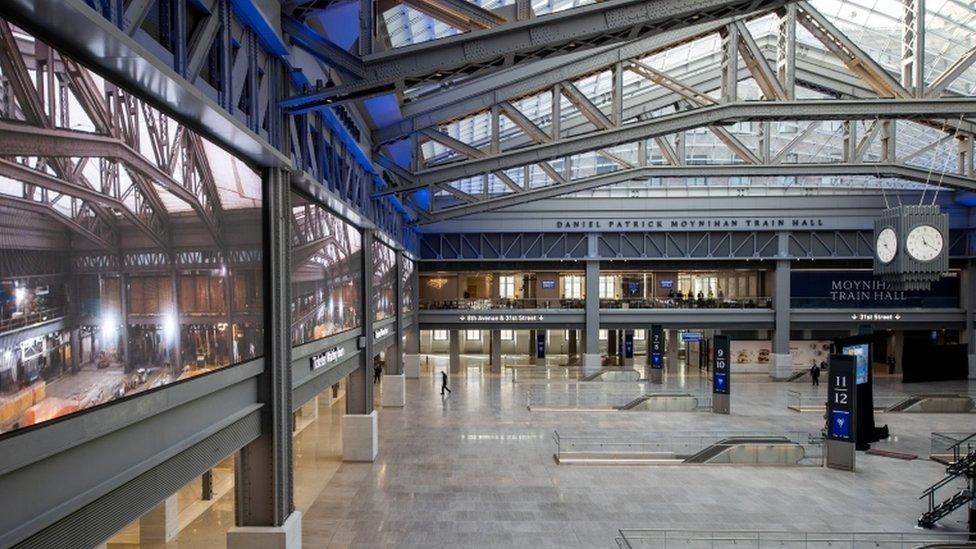Penn Station: New train hall returns beauty to New York station
- Published

The new Penn Station concourse, located in the Farley Post Office, has been a long time coming
For decades, New York City's Penn Station has been famous worldwide for giving its visitors a crowded, dank and generally unpleasant experience.
But now a new design, unveiled on Wednesday, aims to rectify the loss caused when the station's original majestic concourse was demolished in 1963.
Costing $1.6 billion (拢1.2 billion), the Moynihan Train Hall has been built in the Farley Post Office opposite Penn Station.
It opens for business on 1 January.
The original Penn Station was replaced with a basement station decried by most visitors
Named after Senator Daniel Patrick Moynihan who in the 1990s promoted the idea of using the post office building for Penn Station, the new hall in what is the US's busiest station has been a long time coming.
Filled with natural light and art, it harks back to the railway station's glory days.
The original Penn Station was built in 1910, in the heyday of the railroad, and its glamour matched America's grand ambition for the country's future.
Penn Station's colonnaded exterior in its early decades
Built by the architectural firm McKim, Mead and White, the huge building had Doric columns, 150-foot (45m) ceilings and was shaped from the same stone as the Coliseum.
Archive photographs of the interior show high vaulted spaces, with light pouring in and illuminating the building's numerous elegant features.
Penn Station in 1910, the year it was built
But over time it proved expensive to maintain and demand for land in Manhattan grew.
In the 1960s the owners sold the building to make way for the development of Madison Square Garden and the station was bulldozed.
Only a few local architects mourned its loss, but shock turned into action and in 1968, faced with the threat of the bulldozing of another landmark station, Grand Central, a group of activists stepped in.
The station's original neo-classical structure was demolished and the site sold in the 1960s
A newly created New York Landmarks Preservation Commission used legislation called the Landmarks Law to save Grand Central and hundreds of other gems.
Today the law protects 1,400 landmarks, 115 historic interiors, 109 historic districts and 10 scenic landmarks, including Central Park. Almost 30% of Manhattan's buildings are safeguarded.
Just a few activists and architects tried to stop the bulldozing of the station in 1963
But it was too late to save Penn Station and for more than 50 years, commuters and long-distance travellers have been forced to cram into an underground station built of concrete and filled with fluorescent lights.
Numerous proposals to build a concourse befitting of the station's history went nowhere over the years.
After the original was bulldozed, a new station was built in the 1960s
This restoration was conceived of by Senator Moynihan in 1990s who realised that the Post Office building opposite Penn Station, built in a similar style to the original in 1912, could serve as the new train hall.
The project, which required renovation of the Farley Post Office stone facade and its 700 windows, was driven forward by New York Governor Andrew Cuomo
The new hall will serve Amtrak passengers nationally as well as the Long Island rail road
With its free wifi, a nursing lounge for parents, as well as space for shops and restaurants, Mr Cuomo called the hall's opening at a difficult time for the city during the coronavirus pandemic
"It speaks to the brighter days ahead when we will be able to congregate, to pass one another and to share the same space free of fear," he said.
.